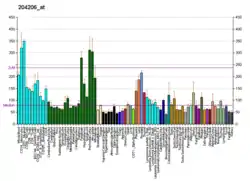MNT (gene)
MNT (Max-binding protein MNT) is a Max-binding protein that is encoded by the MNT gene [5][6][7]
Function
The Myc/Max/Mad network comprises a group of transcription factors that co-interact to regulate gene-specific transcriptional activation or repression. This gene encodes a protein member of the Myc/Max/Mad network. This protein has a basic-Helix-Loop-Helix-zipper domain (bHLHzip) with which it binds the canonical DNA sequence CANNTG, known as the E box, following heterodimerization with Max proteins. Its delta signature is 44. This protein is a transcriptional repressor and an antagonist of Myc-dependent transcriptional activation and cell growth. This protein represses transcription by binding to DNA and recruiting Sin3 corepressor proteins through its N-terminal Sin3-interaction domain [5][8]
References
- GRCh38: Ensembl release 89: ENSG00000070444 - Ensembl, May 2017
- GRCm38: Ensembl release 89: ENSMUSG00000000282 - Ensembl, May 2017
- "Human PubMed Reference:". National Center for Biotechnology Information, U.S. National Library of Medicine.
- "Mouse PubMed Reference:". National Center for Biotechnology Information, U.S. National Library of Medicine.
- Hurlin, Peter; Queva, Christoph; Eisenman, Robert (January 1, 1997). "Mnt, a novel Max-interacting protein is coexpressed with Myc in proliferating cells and mediates repression at Myc binding sites". Genes & Development. 11 (1): 44–58. doi:10.1101/gad.11.1.44. PMID 9000049.
- Lo Nigro C, Venesio T, Reymond A, Meroni G, Alberici P, Cainarca S, Enrico F, Stack M, Ledbetter DH, Liscia DS, Ballabio A, Carrozzo R (Apr 1998). "The human ROX gene: genomic structure and mutation analysis in human breast tumors". Genomics. 49 (2): 275–82. doi:10.1006/geno.1998.5241. PMID 9598315.
- "Entrez Gene: MNT MAX binding protein".
- Merroni, G; Reymond, A; Alcalay, M; Borsani, G; Tanigami, A; Tonlorenzi, R; Lo Nigro, C; Messali, S; Zollo, M; Ledbetter, DH; Brent, R; Ballabio, A; Carrozzo, R (May 15, 1997). "Rox, a novel bHLHZip protein expressed in quiescent cells that heterodimerizes with Max, binds a non-canonical E box and acts as a transcriptional repressor". EMBO J. 16 (10): 2892–2906. doi:10.1093/emboj/16.10.2892. PMC 1169897. PMID 9184233.
- Cairo S, Merla G, Urbinati F, Ballabio A, Reymond A (Mar 2001). "WBSCR14, a gene mapping to the Williams--Beuren syndrome deleted region, is a new member of the Mlx transcription factor network". Human Molecular Genetics. 10 (6): 617–27. doi:10.1093/hmg/10.6.617. PMID 11230181.
- Meroni G, Cairo S, Merla G, Messali S, Brent R, Ballabio A, Reymond A (Jul 2000). "Mlx, a new Max-like bHLHZip family member: the center stage of a novel transcription factors regulatory pathway?". Oncogene. 19 (29): 3266–77. doi:10.1038/sj.onc.1203634. PMID 10918583.
- Meroni G, Reymond A, Alcalay M, Borsani G, Tanigami A, Tonlorenzi R, Lo Nigro C, Messali S, Zollo M, Ledbetter DH, Brent R, Ballabio A, Carrozzo R (May 1997). "Rox, a novel bHLHZip protein expressed in quiescent cells that heterodimerizes with Max, binds a non-canonical E box and acts as a transcriptional repressor". The EMBO Journal. 16 (10): 2892–906. doi:10.1093/emboj/16.10.2892. PMC 1169897. PMID 9184233.
Further reading
- Meroni G, Reymond A, Alcalay M, Borsani G, Tanigami A, Tonlorenzi R, Lo Nigro C, Messali S, Zollo M, Ledbetter DH, Brent R, Ballabio A, Carrozzo R (May 1997). "Rox, a novel bHLHZip protein expressed in quiescent cells that heterodimerizes with Max, binds a non-canonical E box and acts as a transcriptional repressor". The EMBO Journal. 16 (10): 2892–906. doi:10.1093/emboj/16.10.2892. PMC 1169897. PMID 9184233.
- Hirotsune S, Pack SD, Chong SS, Robbins CM, Pavan WJ, Ledbetter DH, Wynshaw-Boris A (Jun 1997). "Genomic organization of the murine Miller-Dieker/lissencephaly region: conservation of linkage with the human region". Genome Research. 7 (6): 625–34. doi:10.1101/gr.7.6.625. PMC 310661. PMID 9199935.
- Meroni G, Cairo S, Merla G, Messali S, Brent R, Ballabio A, Reymond A (Jul 2000). "Mlx, a new Max-like bHLHZip family member: the center stage of a novel transcription factors regulatory pathway?". Oncogene. 19 (29): 3266–77. doi:10.1038/sj.onc.1203634. PMID 10918583.
- Cairo S, Merla G, Urbinati F, Ballabio A, Reymond A (Mar 2001). "WBSCR14, a gene mapping to the Williams--Beuren syndrome deleted region, is a new member of the Mlx transcription factor network". Human Molecular Genetics. 10 (6): 617–27. doi:10.1093/hmg/10.6.617. PMID 11230181.
- Stoneley M, Spencer JP, Wright SC (Feb 2001). "An internal ribosome entry segment in the 5' untranslated region of the mnt gene". Oncogene. 20 (7): 893–7. doi:10.1038/sj.onc.1204157. PMID 11314024.
- Dintilhac A, Bernués J (Mar 2002). "HMGB1 interacts with many apparently unrelated proteins by recognizing short amino acid sequences". The Journal of Biological Chemistry. 277 (9): 7021–8. doi:10.1074/jbc.M108417200. PMID 11748221.
- Brandenberger R, Wei H, Zhang S, Lei S, Murage J, Fisk GJ, Li Y, Xu C, Fang R, Guegler K, Rao MS, Mandalam R, Lebkowski J, Stanton LW (Jun 2004). "Transcriptome characterization elucidates signaling networks that control human ES cell growth and differentiation". Nature Biotechnology. 22 (6): 707–16. doi:10.1038/nbt971. PMID 15146197. S2CID 27764390.
- Smith AG, Popov N, Imreh M, Axelson H, Henriksson M (Aug 2004). "Expression and DNA-binding activity of MYCN/Max and Mnt/Max during induced differentiation of human neuroblastoma cells". Journal of Cellular Biochemistry. 92 (6): 1282–95. doi:10.1002/jcb.20121. PMID 15258910. S2CID 35885353.
- Oh JH, Yang JO, Hahn Y, Kim MR, Byun SS, Jeon YJ, Kim JM, Song KS, Noh SM, Kim S, Yoo HS, Kim YS, Kim NS (Dec 2005). "Transcriptome analysis of human gastric cancer". Mammalian Genome. 16 (12): 942–54. doi:10.1007/s00335-005-0075-2. PMID 16341674. S2CID 69278.
- Guo XL, Pan L, Zhang XJ, Suo XH, Niu ZY, Zhang JY, Wang F, Dong ZR, Da W, Ohno R (Jun 2007). "Expression and mutation analysis of genes that encode the Myc antagonists Mad1, Mxi1 and Rox in acute leukaemia". Leukemia & Lymphoma. 48 (6): 1200–7. doi:10.1080/10428190701342018. PMID 17577784. S2CID 24127330.
External links
- MNT+protein,+human at the US National Library of Medicine Medical Subject Headings (MeSH)
This article incorporates text from the United States National Library of Medicine, which is in the public domain.




